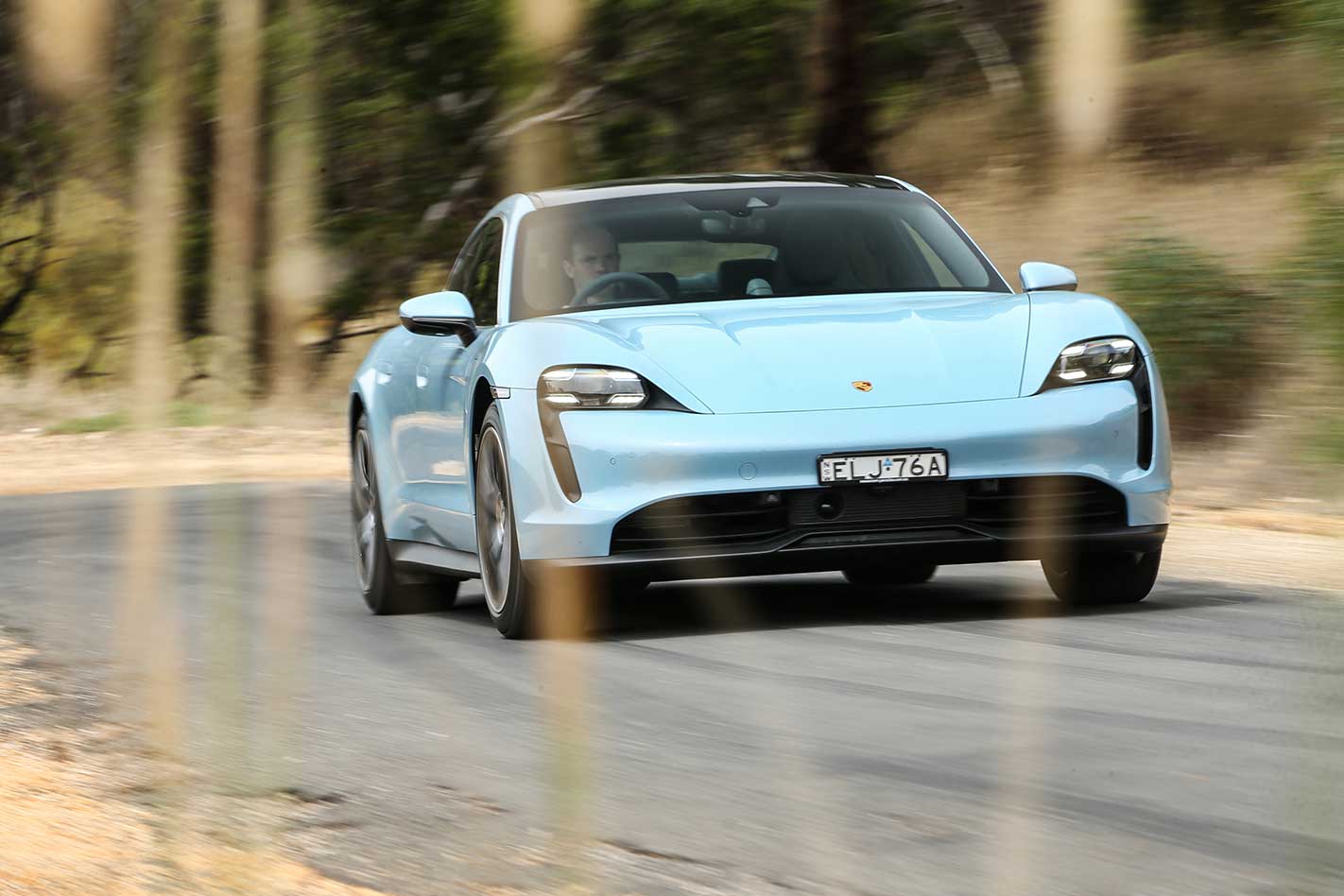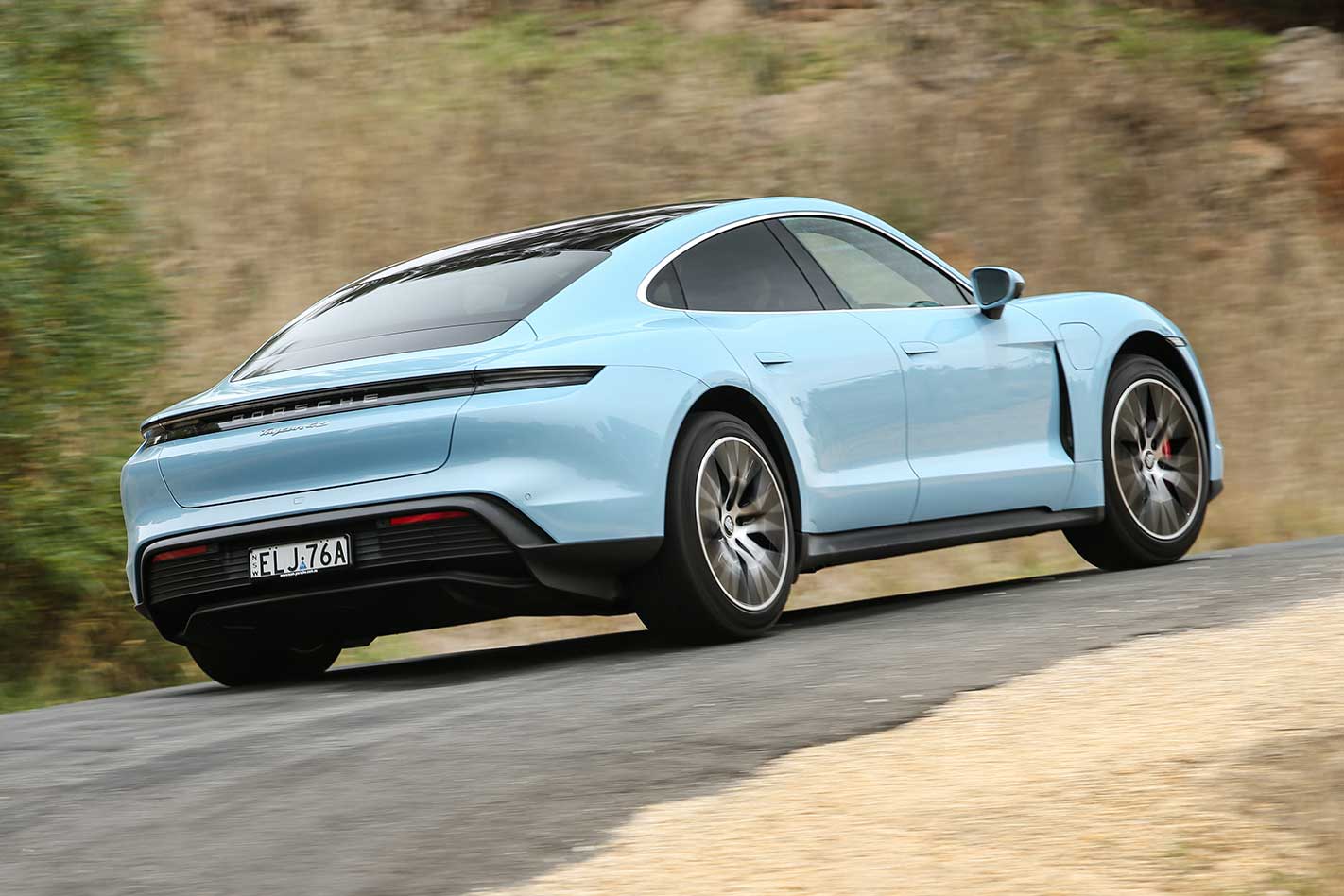If you were taking bets on which manufacturer would not just dip a toe but dive headfirst into the world of electric vehicles then you would have got long odds with Porsche, but here we are with the first Australian drive of the Porsche Taycan 4S.It provides the first real competition to Tesla in the zero-emissions luxury performance market, claiming to offer rocketship acceleration, equally brisk charging times, a long battery range and a clear environmental conscience.




In the centre is a 10.9-inch infotainment touchscreen featuring Apple CarPlay, ‘Hey Porsche’ voice control, internet access, digital radio, a 14-speaker, 710-watt Bose stereo and Porsche Connect, with the ability to sync your calendar, search for restaurants and control certain functions such as air-conditioning via a smartphone app.Below this is a haptic touchscreen containing the HVAC controls, charging information and a touchpad that allows the selection of functions on the main touchscreen or navigation inputs via handwriting. This feels like a screen too far; the climate controls are fine but the touchpad is imprecise and unnecessary when the main screen is within easy reach.


As standard, the Taycan 4S uses a 79.2kWh battery (71.0kWh net) but ticking PBP increases this to 93.4kWh (83.7kWh net) and lifts outputs from 320kW/640Nm to 390kW/650Nm, with 420kW available for launch control standing starts.Porsche claims this drops the 0-200km/h sprint from 13.3 to 12.9sec, though 0-100km/h remains 4.0sec dead. Claimed electrical consumption actually rises from 26.2kWh/100km to 27.0kWh/100km but thanks to the larger battery, claimed range increases from 365km to 414km.



Porsche is working with JetCharge to ensure owners have the appropriate infrastructure at home, the idea being that regardless of the state of charge when you get home of an evening, your Taycan is fully juiced and ready to go the next morning.




Approach a corner and because there is no noise or gear to select, you rely totally on your eyesight to gauge how fast to enter it. This presents difficulties as your perception of speed alters depending on how quickly and for how long you’ve been driving.As familiarity grows you adjust and begin to corner faster; there is impressive grip, though the sportier ’S’ variant of Michelin’s Pilot Sport 4 tyre would generate more, the Taycan never feels flustered and even this ‘non-Turbo’ variant is very quick.


It looks great inside and out, has truly potent performance and is beautiful to drive, making it a fantastic everyday proposition. Porsche has taken a headfirst dive into the pool of electric vehicles and arisen to the applause of the judges.

At a shade under $130K the Tesla has a handy price advantage but like the Porsche, options can increase that dramatically. At 500kW and 0-100km/h in 3.2sec (claimed) it’s also much quicker than the Taycan 4S, though there is unlikely to be much between them in the real world.
However, waiting in the wings is the updated Model S ‘Plaid’, offering Tesla’s latest tech, 760kW, 0-100km/h in a claimed 2.1sec and 600km+ of theoretical range. According to the Tesla website, Australian pricing starts at $174,990 plus on-roads or $189,990 for the even quicker Plaid+.9/10Pros: Refinement; ride; styling; performance; charge speedCons: Screen overload; option requirements; not hugely involvingPorsche Taycan 4S Specifications
Body: 4-door, 5-seat sedan Drive: all-wheel Battery: 93.4kWh (83.7kWh net) Motor: Permanent magnet synchronous (f/r) Power: 390kW (420kW overboost) Torque: 650Nm Power/weight: 176kW/tonne Transmission: single-speed (f); 2-speed (r) Weight: 2220kg Suspension: double wishbone, air springs, adaptive dampers, anti-roll bar (f); multi links, air springs, adaptive dampers, anti-roll bar (r) L/W/H: 4963/1966/1379mm Wheelbase: 2900mm Tracks: 1702/1667mm Steering: electrically assisted rack-and-pinion Brakes: 360mm ventilated discs, 6-piston calipers (f); 358mm ventilated discs, 4-piston calipers (r) Wheels: 20 x 9.0-inch (f); 20 x 11.0-inch (r) Tyres: 245/45 ZR20 (f); 285/40 ZR20 (r) Michelin Pilot Sport 4 Price: $190,400 ($230,530 as-tested: performance battery plus $11,590; leather-free interior $7540; LED matrix headlights $4610; panoramic glass roof $3370; Sport Chrono $2340; passenger display $2150; 20-inch Taycan Turbo rims $1150; Traffic Jam Assist $1200; Porsche electric sport sound $1020; 4+1 seats $1000; ambient lighting $890; Vehicle key in car colour $780; Porsche courtesy lights $600; power steering plus $600; windscreen with grey top tint $240)






